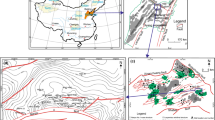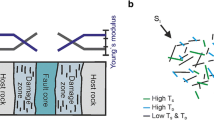Abstract
In-situ stresses have significant impact, either positive or negative, on the short and long term behaviour of fractured reservoirs. The knowledge of the stress conditions are therefore important for planning and utilization of man-made geothermal reservoirs. The geothermal field Groß Schönebeck (40 km north of Berlin/Germany) belongs to the key sites in the northeastern German Basin. We present a stress state determination for this Lower Permian (Rotliegend) reservoir by an integrated approach of 3D structural modelling, 3D fault mapping, stress ratio definition based on frictional constraints, and slip-tendency analysis. The results indicate stress ratios of the minimum horizontal stress S hmin being equal or increasing 0.55 times the amount of the vertical stress S V (S hmin ≥ 0.55S V ) and of the maximum horizontal stress S Hmax ≤ 0.78–1.00S V in stress regimes from normal to strike slip faulting. Thus, acting stresses in the 4,100-m deep reservoir are S V = 100 MPa, S hmin = 55 MPa and S Hmax = 78−100 MPa. Values from hydraulic fracturing support these results. Various fault sets of the reservoir are characterized in terms of their potential to conduct geothermal fluids based on their slip and dilatation tendency. This combined approach can be adopted to any other geothermal site investigation.






Similar content being viewed by others
Abbreviations
- NEGB:
-
Northeast German Basin
- S Hmax :
-
Maximum horizontal stress
- S hmin :
-
Minimum horizontal stress
- S V :
-
Vertical stress
- S 1 :
-
Maximum principle stress
- S 2 :
-
Intermediate principle stress
- S 3 :
-
Minimum principle stress
References
Baltrusch S, Klarner S (1993) Rotliegend-Gräben in NE-Brandenburg. Z dt geol Ges 144:173–186
Barton CA, Zoback MD, Moos D (1995) Fluid flow along potentially active faults in crystalline rock. Geology 23(8):683–686
Bayer U, Maystrenko Y, Hoffmann N, Scheck-Wenderoth M, Meyer H (2003) 3D structural modelling and basin analysis of the Central European Basin System (CEBS) between North Sea and Poland. Terra Nostra 3:1–4
Byerlee J (1978) Friction of rocks. Pure Appl Geophys 116:615–626
Gast R, Gundlach T (2006) Permian strike slip and extensional tectonics in Lower Saxony, Germany. Int J Earth Sci 157(1):41–55
Gehrke D, Moeck I, Schafmeister M-Th, Blöcher G, Zimmermann G (2006) 3D thermo-hydraulic modelling for the geothermal reservoir of Groß Schönebeck (Northeast German Basin). GeoBerlin 2006, 158th annual conference of the DGG, abstract volume:103
Grote R (1998) Die rezente horizontale Hauptspannung im Rotliegenden und Oberkarbon in Norddeutschland. Erdöl Erdgas Kohle 114(10):478–482
Gudmundsson A (2000) Active fault zones and groundwater flow. Geophys Res Lett 27(18):2993–2996
Gudmundsson A, Fjeldskaar I, Brenner SL (2002) Propagation pathways and fluid transport in jointed and layered rocks in geothermal fields. J Volcanol Geotherm Res 116:257–278
Franke D, Hoffman N, Kamps J (1989) Alter und struktureller Bau des Grundgebirges im Nordteil der DDR. Z Angew Geol 35(10/11):289–297
Hecht CA, Lempp C, Scheck M (2003) Geomechanical model for the post-Variscan evolution of the Permocarboniferous-Mesozoic basins in Northeast Germany. Tectonophysics 373:125–139
Holl H-G, Moeck I, Schandelmeier H (2005) Characterization of the tectono-sedimentary evolution of a geothermal reservoir - implications for exploitation (Southern Permian Basin, NE Germany). Proceedings, World Geothermal Congress, Antalya, Turkey
Ito T, Zoback MD (2000) Fracture permeability and in situ stress to 7 km depth in the KTB scientific drillhole. Geophys Res Lett 27:1045–1048
Jaeger JC, Cook NGW, Zimmermann RW (2007) Fundamentals of Rock Mechanics, 4th edn. Blackwell, Oxford
Kaiser A, Reicherter K, Hübscher C, Gajewski D (2004) Variation of the present-day stress field within the North German Basin – insights from thin shell FE modeling based on residual GPS velocities. Tectonophysics 397:55–72
Kopf M (1965) Feldgeologie–Dichtebestimmung, Norddeutsch-Polnisches Becken, Ergebnisbericht. VEB Geophysik Leipzig, Unpublished Report, 47 pp
Legarth B, Huenges E, Zimmermann G (2005) Hydraulic fracturing in a sedimentary geothermal reservoir: results and implications. Int J Rock Mech Mining Sci 42:1028–1041
Lempp C, Lerche I (2006) Correlation of stress directions across the North German Basin: suprasalt and subsalt differences. Z dt Ges Geowiss 157(2):279–298
McCann T (1998) Sandstone composition and provenance of the Rotliegend of the NE German Basin. Sediment Geol 116:177–198
Marotta AM, Bayer U, Thybo H (2000) Origin of the regional stress in the North German Basin: results from numerical modelling. Tectonophysics 360:245–265
Marotta AM, Bayer U, Thybo H, Scheck M (2002) The legacy of the NE German Basin—reactivation by compressional buckling. Terra Nova 12:132–140
Mazur S, Scheck-Wenderoth M, Krzywiec P, (2005) Different modes of the Late Cretaceous-Early Tertiary inversion in the North German and Polish basins. Int J Earth Sci 95(5–6):782–798
Moeck I, Backers T (2006) New ways in understanding borehole breakouts and wellbore stability by fracture mechanics based numerical modelling. In: EAGE 68th Conference and Exhibition, 12–15 June 2006, extended abstracts volume, CD-ROM, P214, Vienna, Austria
Moeck I, Blöcher G, Koch-Moeck M, Holl H-G (2006) 3D structural model building based on 2D seismic and well data using kriging with external drift. In: Pirard E, Dassargues A, Havenith H-B (eds) IAMG 11th international congress—quantitative geology from multiple sources. Extended abstract volume, S14–21, Society for Mathematical Geology, 3–8 September, Liege, Belgium
Morris A, Ferrill DA, Henderson DB (1996) Slip-tendency analysis and fault reactivation. Geology 24(3):275–278
Moos D, Zoback MD (1990) Utilization of observations of well bore failure to constrain the orientation and magnitude of crustal stresses: application to continental, Deep Sea Drilling Project, and Ocean Drilling Program boreholes. J of Geophy Res 95:9305–9325
Moos D, Zoback MD (1993) State of stress in the Long Valley caldera. Geology 21:837–840
Peška P, Zoback MD (1995) Compressive and tensile failure of inclined well bores and determination of in situ stress and rock strength. J Geophy Res 100(B7):12,791–12,811
Reinicke A, Zimmermann G, Huenges E, Burkhardt H (2005) Estimation of hydraulic parameters after stimulation experiments in the geothermal reservoir Groß Schönebeck 3/90 (North-German Basin). Int J Rock Mech Mining Sci 42(7–8):1082–1087
Röckel T, Lempp C (2003) Der Spannungszustand im Norddeutschen Becken. ERDÖL ERDGAS KOHLE 119(2):73–80
Roth F, Fleckenstein P (2001) Stress orientations found in northeast Germany differ from the West European trend. Terra Nova 13:290–298
Scheck M, Bayer U (1999) Evolution of the Northeast German Basin—inference from structural model and subsidence analysis. Tectonophysics 313:145–169
Scheck M, Barrio-Alvers L, Bayer U, Götze HJ (1999) Density structure of the Northeast German Basin: 3D modelling along the DEKORP line BASIN96. Phys Chem Earth (a) 24(3):221–230
Scheck M, Bayer U, Otto V, Lamarche J, Banka D, Pharaoh T (2002) The Elbe fault system in North Central Europe—a basement controlled zone of crustal weakness. Tectonophysics 360:281–299
Scheck M, Bayer U, Lewerenz B (2003) Salt redistribution during extension and inversion inferred from 3D backstripping. Tectonophysics 373:55–73
Weinlich M (1991) Rotliegendbruchsystem und basaler Zechstein in Brandenburg. Z dt geol Ges 142:199–207
Ziegler PA (1990) Geological Atlas of Western and Central Europe, 2nd edn. Shell Int. Petroleum Mij BV and Geol Soc of London (London), pp 1–239
Ziegler PA, Dezes P (2005) Crustal Evolution of Western and Central Europe. In: Gee D, Stephenson RA (Eds) Europe lithosphere dynamics. Memoirs of the Geological Society, London
Zhang X, Sanderson DJ, Barker AJ (2002) Numerical study of fluid flow of deforming fractured rocks using dual porosity permeability model. Geophys J Int 151(2):452–468
Zhang X, Koutsabeloulis N, Heffer K (2007) Hydromechanical modeling of critically stressed and faulted reservoirs. AAPG Bull 91(1):31–50
Zhu W, Wong T-F (1997) The transition from brittle faulting to cataclastic flow in porous sandstone: permeability evolution. J Geophys Res 102:3027–3041
Zoback ML (1992) First and second order patterns of stress in the lithosphere: the World Stress Map project. J Geophys Res 97:11703–11728
Acknowledgments
Special thank is addressed to Agust Gudmundsson and an anonymous referee for helpful and improving comments on this article. Thank is also addressed to D. Bruhn and H. Milsch for valuable advice. We wish to thank Gaz de France-PEG for data release, specially G. Voigtländer and C. Schreyer for friendly cooperation. The 3D model is processed with earthVision®, Dynamic Graphics Inc. (DGI) and 3Dstress, Midland Valley. This multidisciplinary project is a joint research project funded by BMWi, BMBF, BMU, MWI and MWFK.
Author information
Authors and Affiliations
Corresponding author
Rights and permissions
About this article
Cite this article
Moeck, I., Schandelmeier, H. & Holl, HG. The stress regime in a Rotliegend reservoir of the Northeast German Basin. Int J Earth Sci (Geol Rundsch) 98, 1643–1654 (2009). https://doi.org/10.1007/s00531-008-0316-1
Received:
Accepted:
Published:
Issue Date:
DOI: https://doi.org/10.1007/s00531-008-0316-1




